TL;DR:
- Grading is undergoing changes, and many schools or districts need guidance.
- A comprehensive overview of the grading SAMR model, created by Erik Youngman.
Grading should be fair, accurate, meaningful, and clearly communicated. I created the “Grading SAMR Model” to provide a framework for defining indicators within four distinct dimensions. They can be compared, separately or simultaneously, to guide grading analysis, self-evaluation, teaching, or professional development.
Grading should be fair, accurate, meaningful, and clearly communicated. Share on XThe SAMR Model vs. The Grading SAMR Model
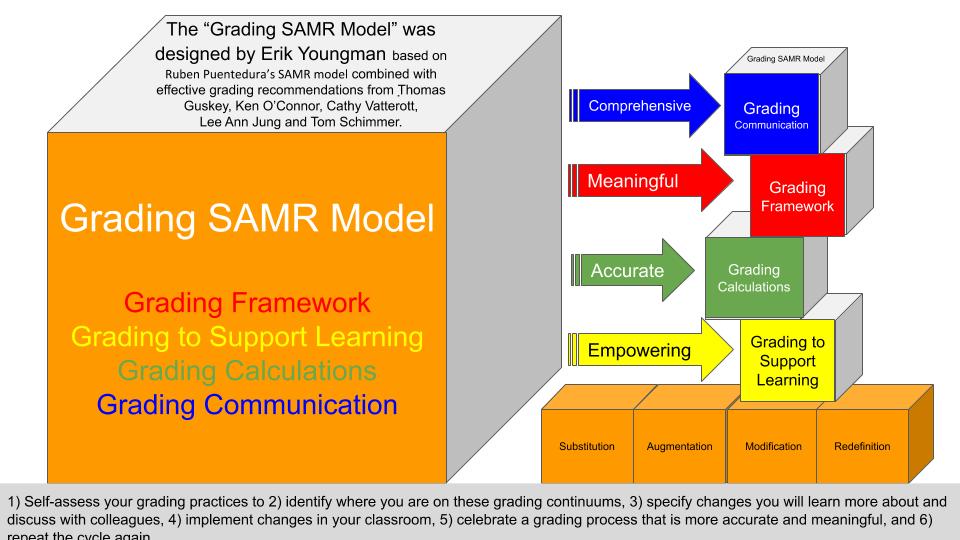
I identified an established model that could be modified to create a continuum that specifies ineffective and effective practices, while also empowering reflection about redefined change. Dr. Ruben Puentedura’s SAMR model that was designed to help educators infuse technology into teaching and learning. It can guide analysis of grading practices.
Similar to the SAMR model, The Grading SAMR Model guides analysis of different SAMR dimensions of substitution, augmentation, modification, and redefinition.
The one distinct difference is with the “S” in SAMR. Rather than being defined as a substitute or replacement with no functional change in the Grading SAMR Model, “S” will be defined as a substitute for subpar dysfunctional practices. The “S” will identify what educators should stop doing and then the “M” and “R” will focus on improvements.
The Grading SAMR Model specifies dysfunctional grading, improved grading, and redefined grading practices to consider. The model is guided by effective grading recommendations from Thomas Guskey, Ken O’Connor, Cathy Vatterott, Lee Ann Jung, and Tom Schimmer. It focuses on empowering grading to support learning that is guided by a meaningful grading framework, accurate grading calculations, and comprehensive grading communication.
Each of these dimensions can be analyzed via the SAMR continuum that includes a sequence of Substitution, Augmentation, Modification, and finally Redefinition.
Each of the dimensions of the Grading SAMR Model are defined in the following way.
- “Substitution Grading” is ineffective and inaccurate.
- “Augmentation Grading,” has no functional improvements.
- “Modification Grading,” has not changed, but has functional improvements.
- “Redefinition Grading” inspires significant task redesign previously inconceivable by fostering a continuous learning mindset.
For this blog, Augmentation will be ignored so we can focus on ineffective Substitution, acceptable Modification, and forward-thinking Redefinition. Grading to support learning will be the first of the four dimensions we explore.
Grading to Support Learning: Common Expectations
Educators should empower grading that supports learning. Focus on common grading expectations, differentiation, ownership, self-assessment, relevant learning, and a growth mindset.
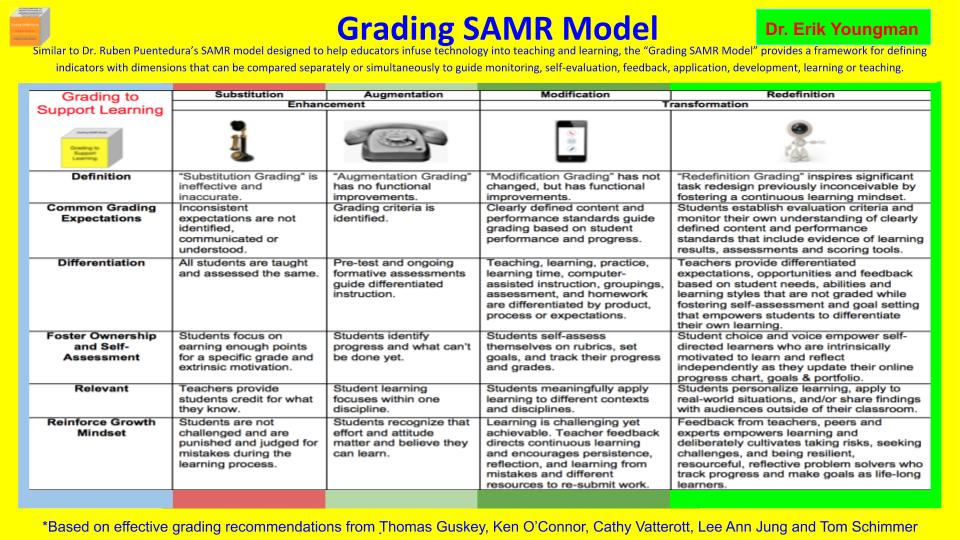
We must have common grading expectations, rather than inconsistent expectations that are not identified, communicated or understood.
Therefore, we focus on clearly defined content and performance standards that guide grading based on student performance and progress.
Ultimately, students establish evaluation criteria and monitor their own understanding of clearly defined expectations. This includes evidence of learning results, assessments, and scoring tools.
Grading to Support Learning: Differentiation
We must also employ differentiation, rather than all students being taught and assessed the same.
To do this, we focus on teaching, learning, practice, learning time, computer-assisted instruction, groupings, assessment, and homework that are differentiated by product, process, or expectations.
Educators should provide differentiated expectations, opportunities, and feedback. It should be based on student needs, abilities, and learning styles that are not graded. In addition, we foster self-assessment and goal setting that empowers students to differentiate their own learning.
Grading to Support Learning: Foster Ownership & Self-Assessment
Educators must foster ownership and self-assessment, rather than utilizing an extrinsic reward system where students focus on earning enough points for a specific grade. We must empower students to self-assess on rubrics, set goals, and track their progress and grades.
Student choice and voice empower self-directed learners who are intrinsically motivated to learn. They reflect independently as they update their online progress chart, goals and portfolio.
Grading to Support Learning: Relevancy
For relevant learning, rather than teachers providing students credit for what they know, empower students to meaningfully apply learning to different contexts and disciplines.
Students should personalize learning, apply to real-world situations, and/or share findings with authentic audiences outside of their classroom.
Grading to Support Learning: A Growth Mindset
We must reinforce a growth mindset through our grading practice. Rather than students not being challenged and being punished and judged for mistakes during the learning process, empower students to recognize that learning is challenging yet achievable.
Teacher feedback directs continuous learning and encourages persistence, reflection, and learning from mistakes to re-submit work.
Feedback from teachers, peers, and experts empowers learning. It deliberately cultivates taking risks, seeking challenges, and being resilient, resourceful, and reflective problem-solvers. Students track progress and make goals as life-long learners.
Grading Framework: Defined Purpose
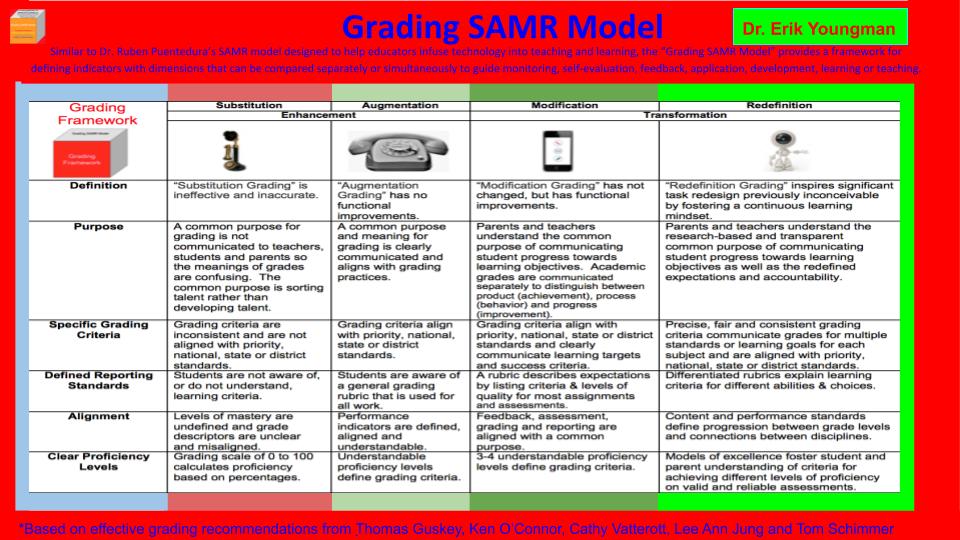
Educators should create a meaningful grading framework guided by purpose, specific grading criteria, defined reporting standards, alignment, and clear proficiency levels.
We should not employ a purpose that focuses on sorting talent rather than developing talent. This is confusing because it is not communicated to teachers, students, and parents, so the meanings of grades are confusing.
As Guskey recommends, academic grades should be communicated separately to distinguish between product (achievement), process (behavior), and progress (improvement).
Parents and teachers should understand the common purpose of communicating student progress towards learning objectives.
Parents and teachers should understand the research-based and transparent common purpose of communicating student progress towards learning objectives, as well as the redefined expectations and accountability.
Grading Framework: Grading Criteria
Grading criteria that is inconsistent and not aligned with priority, national, state or district standards is ineffective.
Educators should focus on grading criteria that aligns with priority, national, state or district standards. It clearly communicates learning targets and success criteria.
We should have precise, fair, and consistent grading criteria. Learning goals for each subject should be aligned with priority, national, state or district standards.
Grading Framework: Reported Standards
Students should be aware of and understand learning criteria. We can do this if we focus on a rubric that describes expectations. Listing criteria and levels of quality is effective.
Educators should have differentiated rubrics that explain learning criteria for different abilities and choices.
Grading Framework: Alignment
Levels of mastery should be defined and grade descriptors should be clear.
To accomplish this, focus on feedback, assessment, grading, and reporting aligned with a common purpose.
Educators should define progression between grade levels and connections between disciplines.
Grading Framework: Proficiency Levels
For clear proficiency levels, rather than a grading scale of 0 to 100 that calculates proficiency based on percentages, focus on 3-4 understandable proficiency levels that define grading criteria.
Educators should have models of excellence. We should foster student and parent understanding of criteria for achieving different levels of proficiency on valid and reliable assessments.
Grading Calculations: Separate Grades for Behavior
Educators should calculate accurate grades by being cognizant of multiple grades. We should use reasonable or fair calculation and criterion-referenced learning standards. Consider question complexity and missing work. Re-assessment and homework must also be addressed.
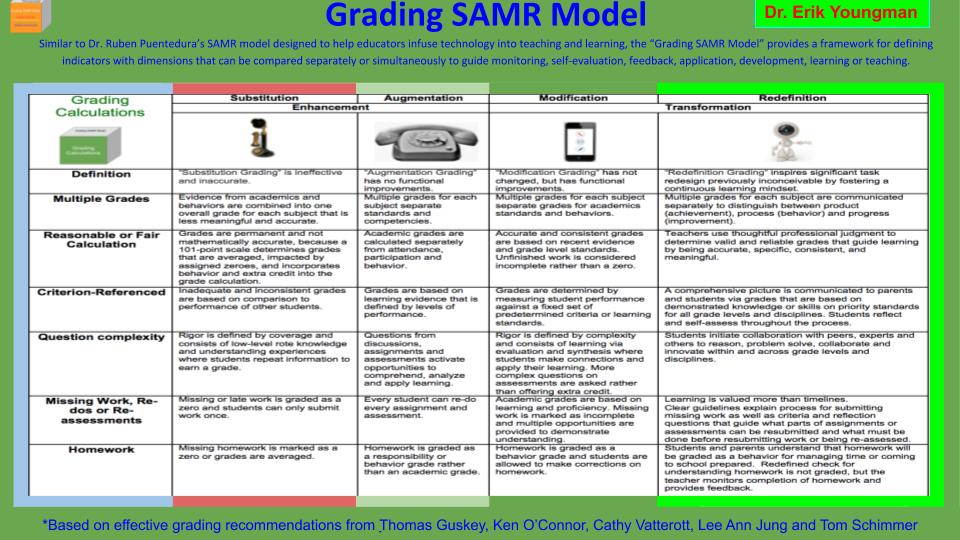
When we combine evidence from academics and behaviors into one overall grade, it is less meaningful and inaccurate.
Instead, use separate grades for academic standards and behaviors. Distinguish between product (achievement), process (behavior) and progress (improvement).
Grading Calculations: Reasonable & Fair
For reasonable or fair calculation, stop assigning permanent grades that are not mathematically accurate. A 101-point scale determines grades that are averaged, impacted by assigned zeroes, and incorporates behavior and extra credit into the grade calculation.
Instead, use recent evidence and grade level standards. Unfinished work is considered incomplete rather than a zero.
Teachers should use thoughtful professional judgment to determine valid and reliable grades that guide learning.
Grading Calculations: Criteria
Inadequate and inconsistent grades are based on comparison to performance of other students. Instead, we should determine grades by measuring student performance against a fixed set of predetermined criteria or learning standards.
We need a comprehensive picture to communicate to parents and students via grades that are based on demonstrated knowledge or skills.
Grading Calculations: Rigor
Rigor should not be defined by coverage that consists of low-level rote knowledge and understanding experiences where students repeat information to earn a grade.
Rather, define rigor by complexity that consists of learning via evaluation and synthesis. This is where students make connections and apply their learning. More complex questions on assessments are asked rather than offering extra credit.
Students initiate collaboration with peers, experts, and others to reason, problem solve, collaborate, and innovate within and across grade levels and disciplines.
Grading Calculations: Missing/Late Work, Retakes, Homework
For missing work, focus on basing academic grades on learning and proficiency. Missing work is marked as incomplete, and multiple opportunities are provided to demonstrate understanding.
Ultimately, learning is valued more than timelines. Clear guidelines explain the process for submitting missing work. Criteria and reflection questions guide what parts of assignments or assessments can be resubmitted, and what must be done before re-submitting work or being reassessed.
For homework, rather than marking missing homework as a zero and/or averaging all grades to determine final grades, use homework as a behavior grade. Allow students to make corrections on homework.
Students and parents should understand that homework will be graded as a behavior for managing time or coming to school prepared. Educators could take this a step further with a redefined “check for understanding homework” that is not graded, but the teacher monitors completion of homework and provides feedback.
Grading Communication: Understandability
Educators should focus on comprehensive grading communication that is cognizant of understandability, two-way communication, student voice, feedback, narrative comments, professional development for parents, sustained teacher professional development, and transitions to different report cards.
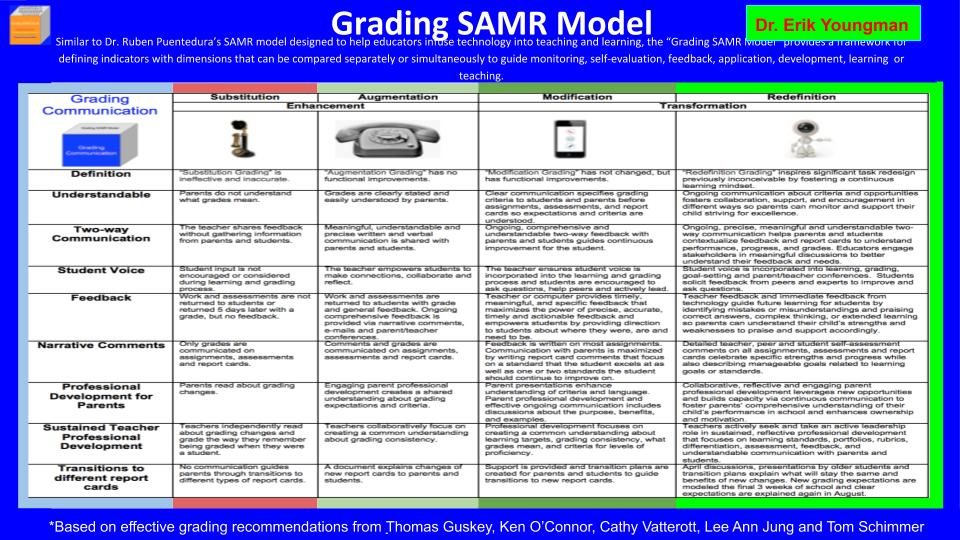
Parents should understand what grades mean. Focus on clear communication to specify grading criteria to students and parents before assignments, assessments, and report cards. Foster collaboration, support, and encouragement in different ways, so parents can monitor and support their child striving for excellence.
Grading Communication: Two-Way
Focus on ongoing, comprehensive, and understandable two-way feedback with parents and students. This guides continuous improvement for the student.
This helps parents and students contextualize feedback and report cards to understand performance, progress, and grades. Educators can also engage stakeholders in meaningful discussions to better understand feedback and needs.
Grading Communication: Student Input
Consider student input during the learning and grading process. Ensure student voice is incorporated into the learning and grading process. That students are encouraged to ask questions, help peers, and actively lead. Students should also have opportunities to solicit feedback from peers and experts to improve and ask questions.
Grading Communication: Feedback
Teachers or computers should provide timely, meaningful, and specific feedback. Maximize the power of precise, accurate, timely and actionable feedback. Empower students by providing direction about where they were, are, and need to be.
Teacher feedback and immediate feedback from technology guide future learning for students.
Write feedback on most assignments. Communication with parents should be maximized by writing report card comments that focus on a standard that the student excels at as well as one or two standards the students should continue to improve on.
Detailed comments celebrate specific strengths and progress while also describing manageable goals related to learning goals or standards.
Grading Communication: Professional Development
Create parent presentations that enhance understanding of criteria and language. Parent professional development and effective ongoing communication should also include discussions about the purpose, benefits, and examples.
Collaborative, reflective and engaging parent professional development leverages new opportunities and builds capacity and enhances ownership and motivation.
Teacher professional development should focus on creating a common understanding about learning targets, grading consistency, what grades mean, and criteria for levels of proficiency.
Provide support and transition plans to guide transitions to new report cards. New grading expectations are modeled the final 3 weeks of school and clear expectations are explained again in August.
Summary
Hopefully the Grading SAMR Model empowers reflection about improvements regarding grading to support learning, guided by a meaningful grading framework, accurate grading calculations, and comprehensive grading communication.
Identification of dysfunctional grading practices should inspire you to collaborate with colleagues to modify and redefine your grading practices so they support and inspire student learning.
You can begin analysis of your grading practices today by doing the following steps.
- Identify where you are on these grading continuums
- Implement changes in your classroom
- Celebrate a grading process that is more accurate and meaningful.
About Erik Youngman
Erik Youngman is an education leader who is passionate about topics such as homework, grading, leadership, and growth mindset. He recently completed his nineteenth year in educational leadership. Erik is the Director of Curriculum, Instruction, and Assessment for Libertyville District 70 in Libertyville, Illinois. Previous education experiences include being a principal in Libertyville as well as an assistant principal and teacher in Gurnee, Illinois.
Erik earned a Doctorate in Educational Leadership, Education Specialist Degree, and Master of Science in Education from Northern Illinois University and a Bachelor of Arts from Augustana College. Please follow and contact Erik via Twitter: @Erik_Youngman.



